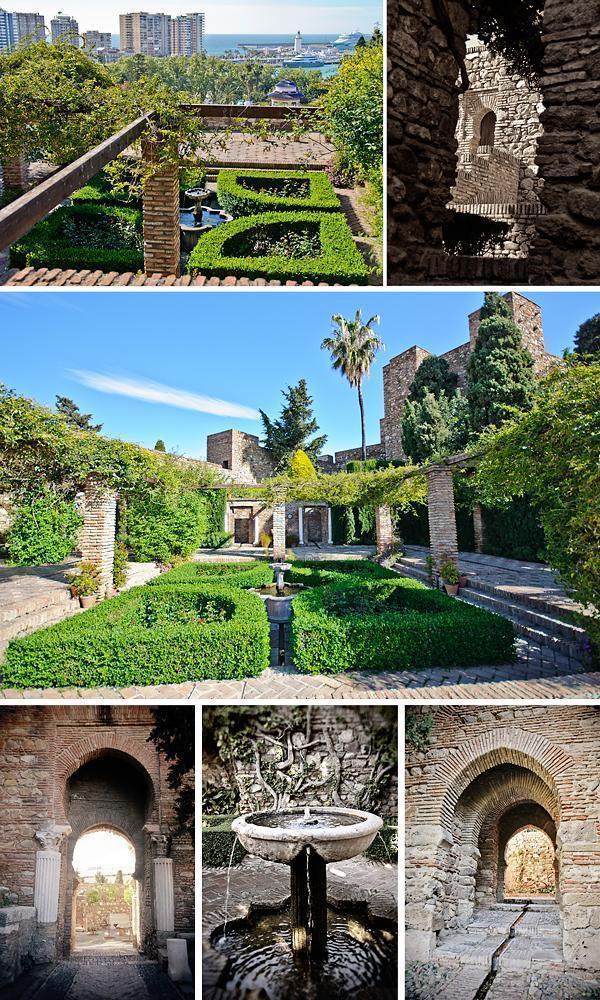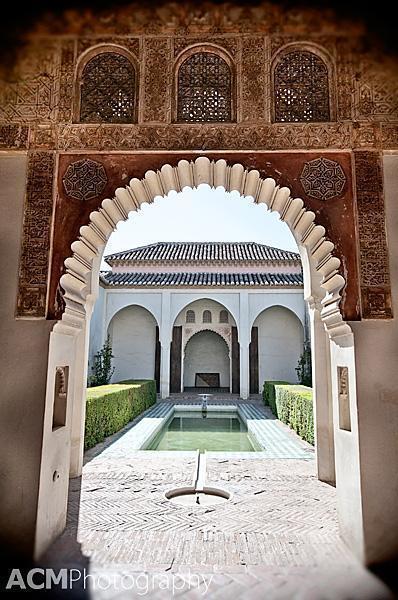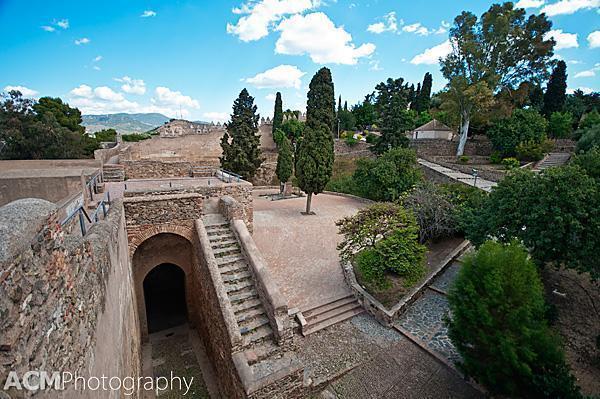
Patio garden of the ‘Cuartos de Granada’ at the Alcazaba of Malaga
The Alcazaba and the Gibralfaro Castle overlook the busy port city of Málaga in Andalusia Spain. These buildings were our first taste of the Moorish architecture so common to this region, which we would continue to see throughout our road-trip through Andalusia.
The Alcazaba of Málaga is a fitting introduction to Andalusia’s Moorish heritage. In fact, it is the best-preserved Moorish fortress-palace in Spain, despite being over-shadowed by the grander and more famous Alcazar of Sevilla and Alhambra of Granada (which we will write about soon). The Alcazaba is actually three centuries older than its well-known neighbours are.
The Alcazaba was built around 756-780AD, during the rule of Abd-al-Rahman I, the first Emir of Cordoba, on the site of a Roman fortification. It protected the city from pirates and on a clear day, it is still possible to see all the way to Africa from its commanding position Mount Gibralfaro.

A commanding view of Malaga and Andalusia, all the way to Africa
The palace was home to a number of Moorish rulers over the centuries, including the Sultan of Granada and the Nasrid ruler Yusuf I, who both left their stamps on the Alcazaba’s architecture. After the reconquest, by the Christians, the Alcazaba was neglected. Despite this, two of the three original walls remain. Reconstruction and preservation efforts have been on going at the Alcazaba since 1933.
Visits to the Alcazaba begin at the Puerta de la Bóveda (Gate of the Vault). From here, you follow the walls up through a succession of Moorish gates, including the Puerta de la Columnas (Gate of the Columns). The Moors repurposed Roman marble columns to reinforce this archway.

The Arches and Gardens of the Alcazaba
As you continue to climb up towards the palaces, you pass through a series of patio gardens. Here you can see the advanced use of water within the Alcazaba. Everywhere there are fountains and channels in the pathways to funnel water throughout the palace complex. You are never far from the soothing sounds of the trickling water that was essential to life here.
The architectural details in the Alcazaba are striking, although they were just a taste of the Moorish flare for decoration we would soon experience in Granada. The Cuartos de Granada, or the Granada Quarters, was the most spectacular, with its decorated ceilings, multifoil arches, and wall tiles.

The Detailed archway of the Cuartos de Granada at the Alcazaba

It’s all in the details at the Alcazaba, Malaga

Window detail in the Alcazaba
From the Alcazaba it’s a long, hot trek up the mountain to reach the Gibralfaro Castle, or Castillo de Gibralfaro, but it is worth it for the view. From the castle ramparts, you can see all of Malaga and the Andalusian coast spread out before you.

Inside Gibralfaro Castle
Gibralfaro Castle dates from 929AD. It was enlarged in the 14th century to protect the Alcazaba. The castle is famous for withstanding a three-month siege by the Catholic Monarchs that ended only when the inhabitants ran out of food.
These days you can walk along the walls to admire the views of Malaga below and relax in the shady open-air cafe before making the trek back down to the city.

Gibralfaro Castle and the views of Malaga, Spain
Our advice is to head to the castle early or late in the day to avoid the worst of the heat and take some water with you. Alternatively, if you prefer not to walk up the mountain, make the trip on one of the hop-on-hop-off buses that circle the city.
Opening Times:
- Tuesday to Sunday
- Summer: 9.30am to 8pm
- Winter: 8.30am to 7pm
- Closed Mondays and 1 Jan, 28 Feb & 25 Dec.
- Tuesday to Sunday
- Summer: 9.30am to 8pm
- Winter: 9am to 6pm
- Closed Mondays and 1 Jan, 28 Feb & 25 Dec.
Tickets:
- Normal admission for either building: 2.10 Euros
- Joint ticket Alcazaba & Gibralfaro: 3.45 Euros
- Reduced: 0.60 euro.
- Free entry Sundays after 2pm.
Love castles, palaces, and ruins like in this article? Us too! Don’t miss the full listing of Castles we’ve visited in Europe and beyond.
- The Ultimate List of Castle Hotels in Belgium - June 10, 2019
- The Ultimate Guide to the Best Things to Do in Normandy, France - February 5, 2019
- The Ultimate Guide to the Best Restaurants in Brussels, Belgium - January 11, 2019
- A Tale of Two Towers in Belém, Lisbon, Portugal
- Jerónimos Monastery, Lisbon, Portugal, in Photos
- Azulejos – The Colourful Tiles of Lisbon
- Visiting the Castle of São Jorge – Lisbon, Portugal
- Lisbon, Portugal – Our 10 Favourite Photos
- Visiting the Sintra National Palace in Portugal
- Visiting Pena National Palace, Sintra, Portugal
- Visiting Monserrate Palace and Gardens, Sintra, Portugal
- Zahara de la Sierra and the Pueblos Blancos of Andalusia, Spain
- Ronda, Spain – Canyons, Cliffs and Bullrings in Andalusia
- Visiting Gibralfaro Castle and the Alcazaba of Malaga, Spain
- Gibraltar is Weird and We Like it that Way
- The Alhambra and Generalife of Granada, Spain in Photos
- Visiting The Cathedral–Mosque of Córdoba, Spain
- Our Favourite Photos from Granada and Cordoba, Spain
- Visiting the Alcázar of Seville, Spain
- Visiting Seville Cathedral and the Giralda, Andalusia, Spain
- Our 10 Favourite Photos from Seville, Spain
- Our Favourite Photos of Architecture in Prague, Czech Republic
- The Weekend London Tried to Kill Me
- Exploring the Tropical Rainforest of the Eden Project, Cornwall, England
- Otters and Butterflies in Dartmoor, England
- Our Favourite Photos of England

